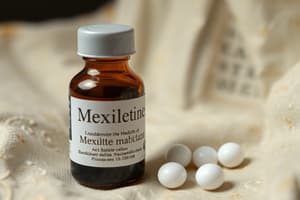Podcast
Questions and Answers
What is the primary use of mexiletine?
What is the primary use of mexiletine?
- Suppressing ventricular cardiac tachyarrhythmias (correct)
- Preventing liver toxicity
- Lowering blood pressure
- Treating neuropathic pain
What is the advantage of adding an amine side group to mexiletine?
What is the advantage of adding an amine side group to mexiletine?
- It enables mexiletine to undergo significant hepatic first-pass metabolism
- It increases the risk of side effects
- It allows mexiletine to be more effective in treating neuropathic pain
- It avoids significant hepatic first-pass metabolism (correct)
What is the usual adult dose of mexiletine?
What is the usual adult dose of mexiletine?
- 150 to 200 mg every 8 hours (correct)
- 300 mg every 24 hours
- 100 mg every 4 hours
- 200 mg every 12 hours
What is the effect of combining mexiletine with a beta blocker or another antiarrhythmic drug?
What is the effect of combining mexiletine with a beta blocker or another antiarrhythmic drug?
What is the electrophysiological similarity of mexiletine to?
What is the electrophysiological similarity of mexiletine to?
Flashcards are hidden until you start studying
Study Notes
Mexiletine Characteristics
- Mexiletine is an orally effective amine analogue of lidocaine.
- It is used for the chronic suppression of ventricular cardiac tachyarrhythmias.
Combination Therapy
- Combination with a beta blocker or another antiarrhythmic drug (e.g., quinidine or procainamide) results in a synergistic effect.
- This synergistic effect permits a decrease in the dose of mexiletine and an associated decrease in the incidence of side effects.
Electrophysiological Properties
- Mexiletine is electrophysiologically similar to lidocaine.
Oral Administration
- Mexiletine avoids significant hepatic first-pass metabolism due to the addition of the amine side group.
- This allows for effective oral administration, unlike lidocaine which is limited by hepatic first-pass metabolism.
Dosing and Administration
- The usual adult dose of mexiletine is 150 to 200 mg every 8 hours.
Potential Use in Pain Management
- Mexiletine may be effective in decreasing neuropathic pain in patients who have not responded to alternative pain medications.
Studying That Suits You
Use AI to generate personalized quizzes and flashcards to suit your learning preferences.


